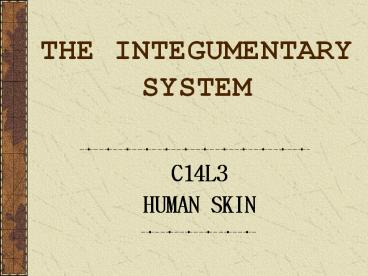THE%20INTEGUMENTARY%20SYSTEM - PowerPoint PPT Presentation
Title: THE%20INTEGUMENTARY%20SYSTEM
1
THE INTEGUMENTARY SYSTEM
- C14L3
- HUMAN SKIN
2
Integumentary System
- skin
- hair
- nails
3
Skin Stats
- Approx. 28 hundred sq. inches (about 18 sq. feet)
of skin cover the body - Average thickness is 1/8 inch
- Weighs 6-9 pounds (6 of the body weight)
- Skin is the largest organ of the human body
4
A piece of skin the size of a quarter contains
- 1 yard of blood vessels
- 4 yards of nerves
- 25 nerve endings
- 100 sweat glands
- more than 3 million cells
5
FUNCTIONS OF THE SKIN
- Protection
- Sensory Response
- Temperature Regulator
- Excretion
- Manufacture
- Absorption
6
Protection(a mechanical shield)
Your skin is one of your bodys major
defenses. The skin does not permit significant
amounts of substances like water in or out of the
body. It keeps your body from drying out.
Bacteria, viruses, and many common chemicals that
you constantly touch would be very harmful if
they penetrated into the body. Skin is an
effective barrier to most of them.
7
Protection(a mechanical shield)
Perspiration and oils secreted by the skin
provide a form of chemical protection which is
acidic and sometimes has enzymes that inhibit the
growth of certain microorganisms.
8
Sensory Response
Nerve receptors for pressure, temperature, and
pain are in the skin. Communication between your
body and the outside world. The more sensory
receptors there are in an area of skin, the more
sensitive it is.
9
Temperature Regulator
The amount of blood being carried to the surface
of the skin is regulated to control the amount of
thermal
energy released. Blood vessels in skin dilate
when you need to cool off and constrict when you
need to conserve heat. Also evaporation of sweat
cools the body.
10
EXCRETION(Secretion)
A small amount of body wastes is excreted with
sweat. sweat glands move moisture to the
surface to cool, also give off certain wastes to
help keep the body clean oil glands (sebaceous)
coat the skin with oils to keep it from drying
out.
11
VITAMIN MANUFACTURE
The skin produces small amounts of vitamin D if
exposed to sunlight.
Vitamin D helps it absorb calcium and phosphorous
to promote bone growth.
As little as 15-20 minutes of sunlight 2-3 days a
week will produce sufficient vitamin D.
12
ABSORPTION
The skin can absorb some chemicals, a fewdrugs,
and asmall amountof oxygen.
13
Layers of the Skin
- Epidermis (1)
- Dermis (2)
- Hypodermis (3)
14
Epidermis
- the outermost layer of the skin has dead cells at
the surface and living cells underneath - contains nerve endings (example pain receptors)
- the older cells of the epidermis fill with a waxy
substance called keratin and die - approximately every 25 days (faster for some
people and in some areas of the body) a
completely new epidermis covers the body
15
Epidermis
- The epidermis produces melanin, which is a
pigment that protects the body by absorbing some
of the Suns damaging ultraviolet rays.
16
Dermis
- the inner, much thicker layer of the skin giving
skin strength, nourishment, and flexibility.
contains connective tissues blood
vessels nerve endings sweat glands
hair follicles oil glands
17
Hypodermis layer
- consists of loosely arranged fat cells and fibers
- the fat cells help to cushion and
- insulate you body
- and store energy
18
Skin
19
Skin Color
Pink color of a person's skin is his blood
showing through. Other colors are the results of
pigments.
- dark pigment - melanin
- yellowish pigment - carotene
20
Melanin
Melanin is produced by special cells
(melanocytes) in the skin.
21
Freckles
Freckles are clumps of cells that contain more
melanin that the rest of the skin.
22
Diseases and Disorders
- Albinism
- Callus
- Blisters
- Boils
- Acne
23
Albinism
People with albinism do not have the ability to
make melanin and thus cannot tan.
24
Callus
a thickened epidermis which helps protect the
deeper layers of the skin
25
Blisters
Blisters are not a form of protection, but a
response to injury. Friction causes layers of
skin to separate and water collects in the
space betweenthe separated layers.
26
Boils
Boils are bacterial infections (the raised
portion of skin is filled with pus)
27
Acne
- Acne is a skin condition that consists of
pimples, deeper lumps (cysts or nodules), and
plugged pores (blackheads and whiteheads), that
occur on the face, neck, chest, back, shoulders,
and even the upper arms.
28
Causes of Acne
- Acne is caused by three major factors
- Overproduction of oil by enlarged oil glands in
the skin. - Blockage of the hair follicles that release oil.
- Growth of bacteria, called P. acnes, within the
hair follicles.
29
Burns
Burns are classified by how deeply they penetrate
the skins surface.
- First Degree
- Second Degree
- Third Degree
30
First Degree
(superficial) involves only the epidermis
31
Second Degree
(partial thickness) involves the epidermis and
some of the dermis
32
Third Degree
(full thickness) destroys the epidermis, dermis,
and into the subcutaneous tissues
33
Burns
Burns are classified by how deeply they penetrate
the skins surface.































